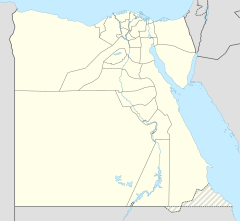Cave of swimmers

Rock art of swimmers
|
|
| Location | Gilf Kebir plateau |
|---|---|
| Region | New Valley Governorate, Egypt |
| Coordinates | 23°35′40.99″N 25°14′0.60″E / 23.5947194°N 25.2335000°ECoordinates: 23°35′40.99″N 25°14′0.60″E / 23.5947194°N 25.2335000°E |
| History | |
| Periods | Neolithic |
| Site notes | |
| Excavation dates | 1933 |
| Archaeologists | László Almásy |
The Cave of Swimmers is a cave with ancient rock art in the mountainous Gilf Kebir plateau of the Libyan Desert section of the Sahara. It is located in the New Valley Governorate of southwest Egypt, near the border with Libya.
The cave and rock art was discovered in October 1933 by the Hungarian explorer László Almásy. It contains Neolithic pictographs (rock painting images) and is named due to the depictions of people with their limbs bent as if they were swimming. They are estimated to have been created as early as 10,000 years ago with the beginning of the African Humid Period, when the Sahara was significantly greener and wetter than it is today.
Almásy devoted a chapter to the cave in his 1934 book, The Unknown Sahara. In it he postulates that the swimming scenes are real depictions of life at the time of painting and that the artists had realistically drawn their surroundings and that there had been a climate change from temperate to xeric desert since that time making it wetter. This theory was so new at that time that his first editor added several footnotes, to make it clear that he did not share this opinion. In 2007, Eman Ghoneim discovered an ancient mega-lake (30,750 km²) buried beneath the sand of the Great Sahara in the Northern Darfur region, Sudan.
The cave is mentioned in Michael Ondaatje's novel The English Patient and the film adaptation based upon it. The cave shown in the film is not the original but a film set created by a contemporary artist.
...
Wikipedia

